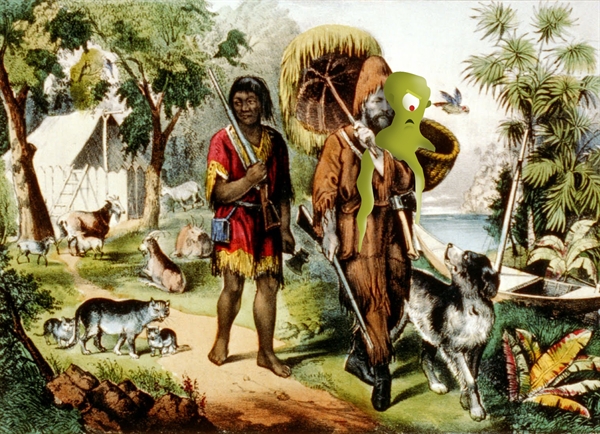Robinson Crusoe Day 2025 is on Saturday, February 1, 2025: Was Robinson Crusoe Fiction?
Saturday, February 1, 2025 is Robinson Crusoe Day 2025. Even Robinson Crusoe has his day Even Robinson Crusoe has his
As an Amazon Associate I earn from qualifying purchases.
Robinson Crusoe is fiction; however, it was inspired by something real that happened to a real person. Being inspired by or based on a real life event doesn't stop something from being fiction - fiction can be inspired by real happenings. It's a fictionalised account of a real event that happened to a sailor called Alexander Selkirk.
It was actually not as uncommon as you might think in those days for sailors to be either marooned deliberately or accidentally, and people had far better survival skills then they do now and a far greater ability to be self-sufficient, so it's not really implausible when you consider the time in which the story was written and set.

A shory summary of the book Robinson Crusoe?
Robinson Crusoe is an Englishman from the town of York in the seventeenth century, the youngest son of a merchant of German origin. Encouraged by his father to study law, Crusoe expresses his wish to go to sea instead. His family is against Crusoe going out to sea, and his father explains that it is better to seek a modest, secure life for oneself. Initially, Robinson is committed to obeying his father, but he eventually succumbs to temptation and embarks on a ship bound for London with a friend. When a storm causes the near deaths of Crusoe and his friend, the friend is dissuaded from sea travel, but Crusoe still goes on to set himself up as merchant on a ship leaving London. This trip is financially successful, and Crusoe plans another, leaving his early profits in the care of a friendly widow. The second voyage does not prove as fortunate: the ship is seized by Moorish pirates, and Crusoe is enslaved to a potentate in the North African town of Sallee. While on a fishing expedition, he and a slave boy break free and sail down the African coast. A kindly Portuguese captain picks them up, buys the slave boy from Crusoe, and takes Crusoe to Brazil. In Brazil, Crusoe establishes himself as a plantation owner and soon becomes successful. Eager for slave labor and its economic advantages, he embarks on a slave-gathering expedition to West Africa but ends up shipwrecked off of the coast of Trinidad.
Crusoe soon learns he is the sole survivor of the expedition and seeks shelter and food for himself. He returns to the wreck’s remains twelve times to salvage guns, powder, food, and other items. Onshore, he finds goats he can graze for meat and builds himself a shelter. He erects a cross that he inscribes with the date of his arrival, September 1, 1659, and makes a notch every day in order never to lose track of time. He also keeps a journal of his household activities, noting his attempts to make candles, his lucky discovery of sprouting grain, and his construction of a cellar, among other events. In June 1660, he falls ill and hallucinates that an angel visits, warning him to repent. Drinking tobacco-steeped rum, Crusoe experiences a religious illumination and realizes that God has delivered him from his earlier sins. After recovering, Crusoe makes a survey of the area and discovers he is on an island. He finds a pleasant valley abounding in grapes, where he builds a shady retreat. Crusoe begins to feel more optimistic about being on the island, describing himself as its “king.” He trains a pet parrot, takes a goat as a pet, and develops skills in basket weaving, bread making, and pottery. He cuts down an enormous cedar tree and builds a huge canoe from its trunk, but he discovers that he cannot move it to the sea. After building a smaller boat, he rows around the island but nearly perishes when swept away by a powerful current. Reaching shore, he hears his parrot calling his name and is thankful for being saved once again. He spends several years in peace.
One day Crusoe is shocked to discover a man’s footprint on the beach. He first assumes the footprint is the devil’s, then decides it must belong to one of the cannibals said to live in the region. Terrified, he arms himself and remains on the lookout for cannibals. He also builds an underground cellar in which to herd his goats at night and devises a way to cook underground. One evening he hears gunshots, and the next day he is able to see a ship wrecked on his coast. It is empty when he arrives on the scene to investigate. Crusoe once again thanks Providence for having been saved. Soon afterward, Crusoe discovers that the shore has been strewn with human carnage, apparently the remains of a cannibal feast. He is alarmed and continues to be vigilant. Later Crusoe catches sight of thirty cannibals heading for shore with their victims. One of the victims is killed. Another one, waiting to be slaughtered, suddenly breaks free and runs toward Crusoe’s dwelling. Crusoe protects him, killing one of the pursuers and injuring the other, whom the victim finally kills. Well-armed, Crusoe defeats most of the cannibals onshore. The victim vows total submission to Crusoe in gratitude for his liberation. Crusoe names him Friday, to commemorate the day on which his life was saved, and takes him as his servant.
Finding Friday cheerful and intelligent, Crusoe teaches him some English words and some elementary Christian concepts. Friday, in turn, explains that the cannibals are divided into distinct nations and that they only eat their enemies. Friday also informs Crusoe that the cannibals saved the men from the shipwreck Crusoe witnessed earlier, and that those men, Spaniards, are living nearby. Friday expresses a longing to return to his people, and Crusoe is upset at the prospect of losing Friday. Crusoe then entertains the idea of making contact with the Spaniards, and Friday admits that he would rather die than lose Crusoe. The two build a boat to visit the cannibals’ land together. Before they have a chance to leave, they are surprised by the arrival of twenty-one cannibals in canoes. The cannibals are holding three victims, one of whom is in European dress. Friday and Crusoe kill most of the cannibals and release the European, a Spaniard. Friday is overjoyed to discover that another of the rescued victims is his father. The four men return to Crusoe’s dwelling for food and rest. Crusoe prepares to welcome them into his community permanently. He sends Friday’s father and the Spaniard out in a canoe to explore the nearby land.
Eight days later, the sight of an approaching English ship alarms Friday. Crusoe is suspicious. Friday and Crusoe watch as eleven men take three captives onshore in a boat. Nine of the men explore the land, leaving two to guard the captives. Friday and Crusoe overpower these men and release the captives, one of whom is the captain of the ship, which has been taken in a mutiny. Shouting to the remaining mutineers from different points, Friday and Crusoe confuse and tire the men by making them run from place to place. Eventually they confront the mutineers, telling them that all may escape with their lives except the ringleader. The men surrender. Crusoe and the captain pretend that the island is an imperial territory and that the governor has spared their lives in order to send them all to England to face justice. Keeping five men as hostages, Crusoe sends the other men out to seize the ship. When the ship is brought in, Crusoe nearly faints.
On December 19, 1686, Crusoe boards the ship to return to England. There, he finds his family is deceased except for two sisters. His widow friend has kept Crusoe’s money safe, and after traveling to Lisbon, Crusoe learns from the Portuguese captain that his plantations in Brazil have been highly profitable. He arranges to sell his Brazilian lands. Wary of sea travel, Crusoe attempts to return to England by land but is threatened by bad weather and wild animals in northern Spain. Finally arriving back in England, Crusoe receives word that the sale of his plantations has been completed and that he has made a considerable fortune. After donating a portion to the widow and his sisters, Crusoe is restless and considers returning to Brazil, but he is dissuaded by the thought that he would have to become Catholic. He marries, and his wife dies. Crusoe finally departs for the East Indies as a trader in 1694. He revisits his island, finding that the Spaniards are governing it well and that it has become a prosperous colony.

Robinson Crusoe - Synopsis Summary !?
Crusoe leaves England setting sail from the Queens Dock in Hull on a sea voyage in September, 1651, against the wishes of his parents. The ship is taken over by Salè pirates and Crusoe becomes the slave of a Moor. He manages to escape with a boat and is befriended by the Captain of a Portuguese ship off the western coast of Africa. The ship is en route to Brazil. There with the help of the captain, Crusoe becomes owner of a plantation.
He joins an expedition to bring slaves from Africa, but he is shipwrecked in a storm about forty miles out to sea on an island near the mouth of the Orinoco river on September 30, 1659. His companions all die; he manages to fetch arms, tools and other supplies from the ship before it breaks apart and sinks. He proceeds to build a fenced-in habitation and cave, keeps a calendar by making marks in a wooden cross he builds. He hunts, grows corn, learns to make pottery, raises goats, etc. He reads the Bible and suddenly becomes religious, thanking God for his fate in which nothing is missing but society.
He discovers native cannibals occasionally visit the island to kill and eat prisoners. At first he plans to kill the savages for their abomination, but then he realizes that he has no right to do so as the cannibals have not attacked him and do not knowingly commit a crime. He dreams of capturing one or two servants by freeing some prisoners, and indeed, when a prisoner manages to escape, Crusoe helps him, naming his new companion "Friday" after the day of the week he appeared, and teaches him English and converts him to Christianity.
After another party of natives arrive to partake in a grisly feast, Crusoe and Friday manage to kill most of the natives and save two of the prisoners. One is Friday's father and the other is a Spaniard, who informs Crusoe that there are other Spaniards shipwrecked on the mainland. A plan is devised where the Spaniard would return with Friday's father to the mainland and bring back the others, build a ship, and sail to a Spanish port.
Before the Spaniards return, an English ship appears; mutineers have taken control of the ship and intend to maroon their former captain on the island. The captain and Crusoe manage to retake the ship. They leave for England, leaving behind three of the mutineers to fend for themselves and inform the Spaniards what happened. Crusoe leaves the island on December 19, 1686. He travels to Portugal to find his old friend, the captain, who informs him that his Brazilian plantation was well cared for and he has become wealthy. From Portugal, he travels overland to England, to avoid mishaps at sea, via Spain and France; during winter in the Pyrenees, he and his companions have to fend off an attack by vicious wolves. Back in England, he decides to sell his plantation, as returning to Brazil would entail converting to Catholicism. Later in life, after marrying, having three children and becoming widowed, he returns to his island for a last time. The book ends with a hint about a sequel that would detail his return to the island, which had been discovered.

























